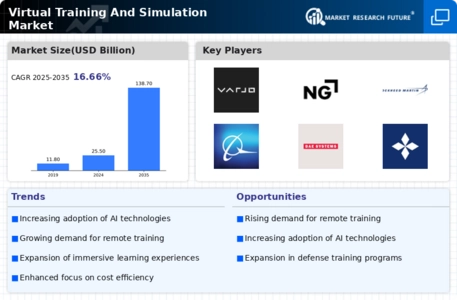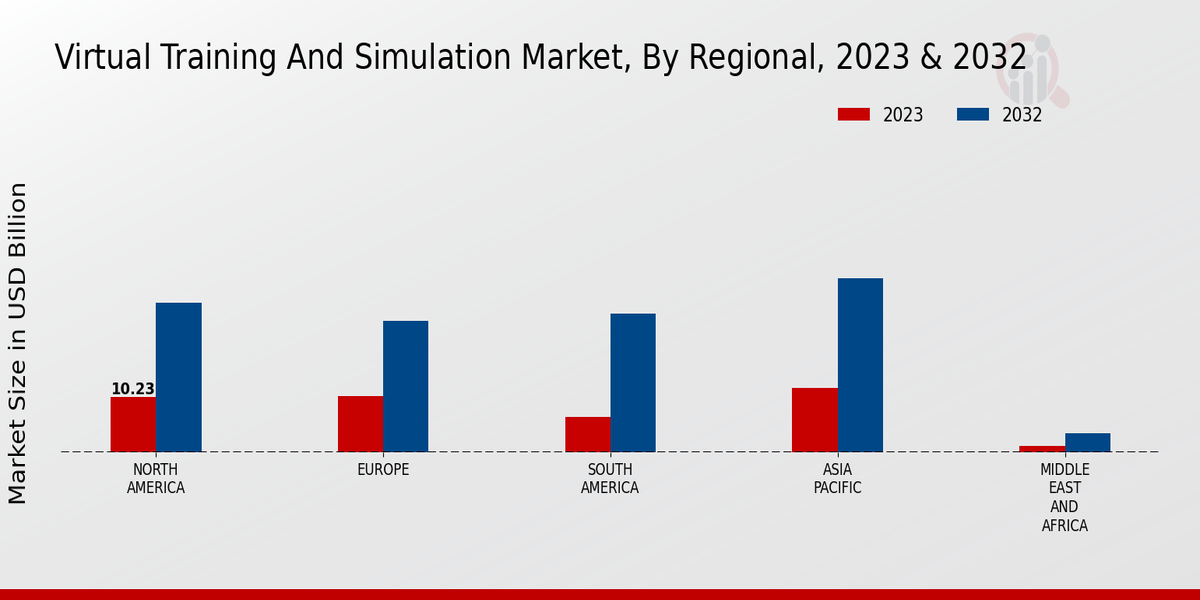Rise of Remote Work and Learning
The rise of remote work and learning is significantly influencing the Virtual Training And Simulation Market. As organizations adapt to flexible work arrangements, the need for effective remote training solutions has become paramount. Virtual training platforms enable employees to access training materials from anywhere, facilitating continuous learning regardless of location. This shift has led to an increased investment in virtual training technologies, with the market projected to grow at a compound annual growth rate of 15% over the next five years. Companies are recognizing the importance of maintaining employee skills and knowledge in a remote environment, further driving the demand for virtual training solutions. The Virtual Training And Simulation Market is thus positioned to thrive in this evolving landscape.
Growing Demand for Skill Development
The Virtual Training And Simulation Market is experiencing a notable surge in demand for skill development across various sectors. Organizations are increasingly recognizing the necessity of upskilling their workforce to remain competitive. This trend is particularly evident in industries such as healthcare, manufacturing, and defense, where specialized skills are paramount. According to recent data, the market for virtual training solutions is projected to reach USD 325 billion by 2025, driven by the need for effective training methodologies. Companies are investing in immersive training experiences that enhance learning retention and engagement. As a result, the Virtual Training And Simulation Market is likely to expand, catering to the evolving needs of businesses seeking to enhance employee capabilities.
Cost-Effectiveness of Virtual Training
The cost-effectiveness of virtual training solutions is a significant driver for the Virtual Training And Simulation Market. Organizations are increasingly seeking ways to reduce training expenses while maximizing learning outcomes. Traditional training methods often involve high costs related to travel, materials, and instructor fees. In contrast, virtual training offers a scalable solution that minimizes these expenses. A recent analysis indicates that companies can save up to 30% on training costs by adopting virtual training platforms. This financial incentive is compelling for businesses aiming to optimize their training budgets. Consequently, the Virtual Training And Simulation Market is likely to witness continued growth as organizations prioritize cost-effective training solutions that do not compromise on quality.
Enhanced Engagement through Gamification
The incorporation of gamification elements in training programs is transforming the Virtual Training And Simulation Market. Gamification enhances learner engagement by introducing game-like features such as rewards, challenges, and interactive scenarios. This approach not only makes training more enjoyable but also improves knowledge retention. Research suggests that gamified training can increase engagement levels by up to 60%, leading to better learning outcomes. As organizations strive to create more engaging training experiences, the demand for gamified virtual training solutions is expected to rise. This trend indicates a shift towards more interactive and immersive training methodologies within the Virtual Training And Simulation Market, appealing to a diverse range of learners.
Regulatory Compliance and Safety Training
Regulatory compliance and safety training are critical drivers for the Virtual Training And Simulation Market. Industries such as aviation, healthcare, and construction are subject to stringent regulations that necessitate ongoing training for employees. Virtual training solutions provide an effective means to deliver compliance training in a flexible and accessible manner. For instance, the aviation sector utilizes simulation-based training to ensure pilots and crew are well-versed in safety protocols. The increasing emphasis on safety and compliance is likely to propel the demand for virtual training solutions, as organizations seek to mitigate risks and ensure adherence to regulations. This trend underscores the importance of the Virtual Training And Simulation Market in fostering a culture of safety and compliance.



 Source: Primary Research, Secondary Research, Market Research Future Database and Analyst Review
Source: Primary Research, Secondary Research, Market Research Future Database and Analyst Review













Leave a Comment